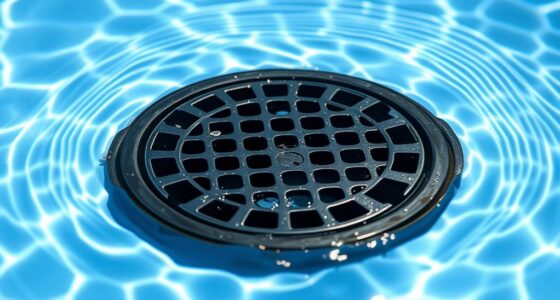To keep your furry friends safe around water, always supervise them near the pool and install barriers like fences or covers to prevent accidental falls. Train your dog to stay away from pool edges and consider using alarms or safety gear such as life jackets. If an emergency occurs, stay calm and use proper rescue techniques to help your pet. Continuing this guide will give you important tips to ensure your dog’s safety and quick response in any water situation.
Key Takeaways
- Always supervise pets closely when they are near the pool area.
- Install physical barriers like fences and pool covers to prevent accidental falls.
- Train pets to stay away from pool edges and recognize water hazards.
- Keep rescue equipment nearby and learn pet water rescue techniques regularly.
- Use safety gear such as life jackets and pool alarms to enhance water safety for pets.

Having a pool during the warmer months can be fun, but it also poses serious safety risks for your pets. Dogs, especially, can accidentally fall in and find themselves struggling to get out. Understanding dog pool hazards is essential to prevent emergencies. Unlike humans, dogs don’t always recognize the danger of water, so they may jump in without warning or get trapped if the pool isn’t properly secured. Small dogs or those with limited mobility are particularly vulnerable. It’s crucial to supervise your pet at all times when they’re near the pool area. Fences, pool covers, and barriers can help keep your furry friends safe from unintentional dips. Still, accidents happen, so knowing pet water rescue techniques can make all the difference if your dog does fall in.
If your pet falls into the pool, your first priority is to stay calm. Panicking can make the situation worse. Approach your dog carefully, avoiding sudden movements that might cause them to panic or struggle more. Reach for a long-handled object, like a pole or a pool skimmer, to gently assist your dog out if they’re close enough. If they’re struggling in the water and can’t reach the edge, you’ll need to perform a pet water rescue. In this case, you should have a plan in place. Approach your dog from behind if possible, and support their body calmly. Using a flotation device or a towel can help you grip and lift them out more securely. Once you’ve pulled your dog out, dry them off and check for signs of distress or injury. If they seem unresponsive, are coughing, or show signs of hypothermia, seek veterinary care immediately. Remember, proper rescue techniques are crucial for safe and effective assistance.
Prevention is always better than cure. Keep your pool area secure with fencing and cover the water when it’s not in use. Train your dog to stay away from the pool’s edge, and never leave them unsupervised around water. Installing alarms or sensors that alert you if someone enters the pool area can add another layer of safety. Remember, even a confident swimmer can get into trouble if they become exhausted or scared. Knowing pet water rescue techniques equips you with the knowledge to act swiftly and confidently, potentially saving your dog’s life. Regularly review these techniques and ensure your pet’s safety gear, like life jackets, is in good condition. By taking these precautions, you can enjoy the warm weather while keeping your furry friends safe, happy, and healthy around water.
Frequently Asked Questions
Can Dogs Drown in Shallow Water?
You might wonder if dogs can drown in shallow water. The answer is yes; even in shallow water, a dog can drown if they become exhausted, panicked, or trapped. It’s vital to supervise your dog near any water, regardless of depth. Always keep an eye on them, especially if they’re not strong swimmers. Preventing dog drowning in shallow water is essential for keeping your furry friend safe and happy.
How Often Should I Clean the Pool for Pet Safety?
You should clean your pool regularly to guarantee water quality maintenance and a safe environment for your pets. Aim for a weekly pool cleaning schedule, especially if your pets frequently swim. This helps remove debris, bacteria, and algae, reducing health risks. Regular maintenance keeps the water fresh and safe, preventing potential dangers like infections or irritation. Staying consistent with pool cleaning is essential for your pet’s safety and overall pool hygiene.
Are Pool Covers Safe for Pets?
Pool covers can be safe for pets if you choose the right type. Pool cover types like mesh, solid, or automatic covers each offer different benefits. Look for pet proof covers designed specifically to prevent pets from slipping in or getting trapped. Always supervise your furry friends around the pool, and verify the cover is secure and in good condition. Properly selected, a pool cover can add safety and peace of mind.
What Signs Indicate My Pet Is Exhausted or in Distress?
Many believe animals always recover quickly from exertion, but studies show signs of fatigue or distress can appear rapidly. Watch for signs of fatigue like heavy panting, slowed movements, or lying down suddenly. Signs of distress include whining, excessive scratching, or frantic attempts to escape water. If you notice these, gently remove your pet from the water, give them a break, and seek veterinary advice if symptoms persist.
Is It Safe to Leave Pets Unattended Near the Pool?
You might wonder if it’s safe to leave pets unattended near the pool. The supervision importance can’t be overstated, as pets unfamiliar with water or showing signs of distress are at higher risk. Never leave your pet alone around water, even if they’re water familiar. Constant supervision helps prevent accidents and guarantees quick response if they struggle. Always keep a close eye on your furry friend when they’re near the pool area.
Conclusion
To keep your furry friends safe around water, stay vigilant and never leave them unattended. Think of your pool as a playground with hidden dangers—your job is to be the vigilant guardian. With simple precautions like fencing, supervision, and training, you create a safe oasis rather than a risky pond. Protecting your pets guarantees that their love for water remains a joyful splash, not a tragedy waiting to happen.










